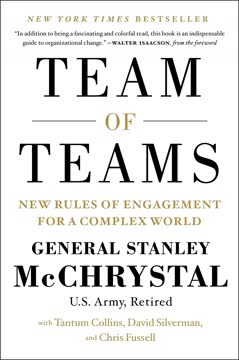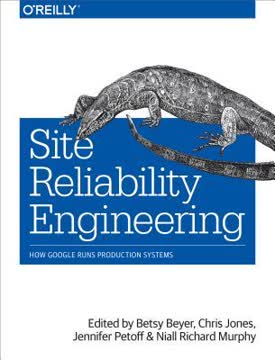Key Takeaways
1. DevOps: Bridging the Gap Between Development and Operations
DevOps relies on bodies of knowledge from Lean, Theory of Constraints, the Toyota Production System, resilience engineering, learning organizations, safety culture, human factors, and many others.
Breaking down silos. DevOps is a cultural and professional movement that aims to break down the traditional barriers between software development and IT operations. By fostering collaboration and shared responsibility, DevOps enables organizations to deliver software faster, more reliably, and with higher quality.
Accelerating delivery. The core principles of DevOps include:
- Continuous Integration and Continuous Delivery (CI/CD)
- Infrastructure as Code
- Automated testing and deployment
- Monitoring and logging
- Collaboration and communication
By adopting these practices, organizations can significantly reduce the time it takes to move from idea to production, while simultaneously improving the stability and reliability of their systems.
2. The Three Ways: Flow, Feedback, and Continuous Learning
The First Way enables fast left-to-right flow of work from Development to Operations to the customer. In order to maximize flow, we need to make work visible, reduce our batch sizes and intervals of work, build in quality by preventing defects from being passed to downstream work centers, and constantly optimize for the global goals.
The First Way: Flow. This principle focuses on optimizing the flow of work from development to operations to the customer. Key practices include:
- Visualizing work
- Reducing batch sizes
- Eliminating bottlenecks
- Continuous integration and delivery
The Second Way: Feedback. This principle emphasizes creating fast and constant feedback loops throughout the entire value stream. It involves:
- Automated testing
- Real-time monitoring and alerting
- Post-incident reviews
The Third Way: Continuous Learning. This principle promotes creating a culture of continuous experimentation and learning. It includes:
- Allocating time for improvement work
- Encouraging experimentation
- Sharing knowledge across the organization
3. Selecting and Improving Value Streams
Imagine a world where product owners, Development, QA, IT Operations, and Infosec work together, not only to help each other, but also to ensure that the overall organization succeeds.
Identifying value streams. A value stream represents the series of steps required to deliver a product or service to the customer. In DevOps, it's crucial to identify and map out these streams to understand where improvements can be made.
Optimizing for flow. Once value streams are identified, teams should focus on:
- Eliminating waste and non-value-adding activities
- Reducing handoffs between teams
- Automating repetitive tasks
- Standardizing processes where possible
By continuously improving value streams, organizations can reduce lead times, improve quality, and increase customer satisfaction.
4. Creating a Culture of Experimentation and Learning
When failures and accidents occur, we treat them as opportunities for learning, as opposed to a cause for punishment and blame.
Fostering psychological safety. A key aspect of DevOps culture is creating an environment where team members feel safe to take risks, experiment, and learn from failures. This involves:
- Encouraging open communication
- Celebrating learning from failures
- Promoting cross-functional collaboration
Continuous improvement. DevOps organizations prioritize ongoing learning and improvement through:
- Regular retrospectives
- Blameless post-mortems
- Allocating time for experimentation and innovation
- Knowledge sharing sessions and internal tech talks
By embracing a culture of experimentation and learning, organizations can adapt more quickly to changing market conditions and continuously improve their products and processes.
5. Integrating Security into the DevOps Pipeline
We must design our systems so that they are continually creating telemetry, widely defined as "an automated communications process by which measurements and other data are collected at remote points and are subsequently transmitted to receiving equipment for monitoring."
Shifting security left. DevOps emphasizes integrating security practices throughout the entire software development lifecycle, rather than treating it as an afterthought. This approach, often called "DevSecOps," involves:
- Automated security testing in CI/CD pipelines
- Regular vulnerability assessments
- Security training for all team members
- Implementing security as code
Continuous monitoring. DevOps practices promote the use of real-time monitoring and alerting to detect and respond to security issues quickly. This includes:
- Log analysis and anomaly detection
- Intrusion detection systems
- Automated incident response
- Regular security audits and penetration testing
By making security an integral part of the DevOps process, organizations can reduce the risk of breaches and improve their overall security posture.
6. Automating Deployment and Infrastructure
Our goal is ensure that we are not only delivering fast flow, but that our deployments can also be performed without causing chaos and disruptions such as service outages, service impairments, or security or compliance failures.
Infrastructure as Code. DevOps promotes treating infrastructure configuration as code, which allows for:
- Version control of infrastructure changes
- Automated provisioning and scaling
- Consistent environments across development, testing, and production
- Easier disaster recovery
Continuous Deployment. Automating the deployment process enables:
- Faster and more frequent releases
- Reduced human error in deployments
- Easier rollbacks in case of issues
- Improved confidence in the release process
By automating deployment and infrastructure management, organizations can achieve greater consistency, reliability, and efficiency in their operations.
7. Measuring and Improving Performance
We have decisive evidence of the business value of DevOps. From 2013 through 2016, as part of Puppet Labs' State Of DevOps Report, to which authors Jez Humble and Gene Kim contributed, we collected data from over twenty-five thousand technology professionals, with the goal of better understanding the health and habits of organizations at all stages of DevOps adoption.
Key metrics. DevOps emphasizes measuring and improving key performance indicators, including:
- Deployment frequency
- Lead time for changes
- Mean time to recover (MTTR)
- Change failure rate
Data-driven decision making. By collecting and analyzing these metrics, organizations can:
- Identify bottlenecks and areas for improvement
- Make informed decisions about process changes
- Demonstrate the business value of DevOps practices
- Set realistic goals and track progress over time
Continuous measurement and improvement are essential for organizations to realize the full benefits of DevOps and stay competitive in rapidly changing markets.
8. Organizational Transformation and Leadership in DevOps
Leaders must elevate the value of learning and disciplined problem solving.
Leadership support. Successful DevOps transformations require strong leadership support and commitment. This involves:
- Aligning DevOps initiatives with business goals
- Providing resources and time for learning and improvement
- Breaking down organizational silos
- Encouraging cross-functional collaboration
Cultural change. DevOps requires a significant shift in organizational culture, including:
- Fostering trust and transparency
- Encouraging experimentation and calculated risk-taking
- Promoting continuous learning and improvement
- Empowering teams to make decisions
Leaders play a crucial role in driving and sustaining the cultural changes necessary for DevOps success. By modeling the desired behaviors and consistently reinforcing DevOps principles, they can help create an environment where DevOps practices can thrive and deliver value to the organization.
Last updated:
FAQ
What's The DevOps Handbook about?
- DevOps Principles: The DevOps Handbook by Gene Kim focuses on integrating Development and Operations to enhance software delivery and operational performance. It emphasizes collaboration and shared responsibility.
- Three Ways Framework: The book introduces the "Three Ways" framework, which includes Flow, Feedback, and Continual Learning and Experimentation, guiding organizations in improving their DevOps practices.
- Real-World Case Studies: It provides numerous case studies from organizations that have successfully implemented DevOps, illustrating challenges and solutions in enhancing performance.
Why should I read The DevOps Handbook?
- Improve Organizational Performance: The book offers actionable insights to enhance software delivery processes, leading to improved performance and customer satisfaction.
- Learn from Experts: Authored by recognized leaders in the DevOps community, it provides a solid foundation for understanding and implementing DevOps practices.
- Stay Competitive: Adopting DevOps is crucial in today's fast-paced technology landscape, and the book outlines how organizations can innovate and respond to market changes effectively.
What are the key takeaways of The DevOps Handbook?
- Collaboration is Essential: Successful DevOps transformations require breaking down silos between Development, Operations, QA, and Security teams.
- Automate Everything: Automation in testing, deployment, and infrastructure management is crucial to reduce errors and increase efficiency.
- Continuous Improvement: A culture of continual learning and experimentation is vital for organizations to regularly assess and improve their processes.
What is the "Three Ways" framework in The DevOps Handbook?
- First Way - Flow: Focuses on optimizing the flow of work from Development to Operations, reducing batch sizes, and ensuring quality is built into the process.
- Second Way - Feedback: Emphasizes creating fast feedback loops at all stages to detect and correct problems early, fostering a culture of learning.
- Third Way - Continual Learning: Encourages a culture of experimentation and learning, integrating lessons from failures to enhance performance.
What are some common myths about DevOps discussed in The DevOps Handbook?
- Myth: Only for Startups: DevOps is applicable across various industries and company sizes, not just startups.
- Myth: Replaces Agile: DevOps is a continuation of Agile principles, enhancing them by including operational aspects.
- Myth: Eliminates IT Operations: IT Operations remains vital, with DevOps transforming its role to enable collaboration with Development teams.
How does The DevOps Handbook define "technical debt"?
- Definition of Technical Debt: It refers to the consequences of decisions that make problems harder to fix over time, akin to accumulating interest in financial debt.
- Impact on Organizations: Technical debt can hinder innovation and responsiveness to market changes, leading to increased firefighting and reduced productivity.
- Managing Technical Debt: The authors recommend proactively addressing technical debt as part of regular work to maintain a healthy codebase.
What role does culture play in a successful DevOps transformation according to The DevOps Handbook?
- High-Trust Environment: A high-trust culture encourages experimentation and learning from failures, fostering open communication and collaboration.
- Shared Goals: Establishing shared goals across teams aligns efforts and breaks down silos, promoting teamwork.
- Continuous Learning: Encouraging a culture of continual learning and improvement is essential for adapting to changes and enhancing performance.
How can organizations measure the success of their DevOps initiatives?
- Key Performance Indicators (KPIs): Use KPIs like deployment frequency, lead time for changes, and mean time to recover from failures to measure success.
- Employee Satisfaction: High employee satisfaction and engagement often correlate with successful DevOps transformations.
- Customer Feedback: Positive customer experiences regarding service quality and reliability indicate successful DevOps initiatives.
What is Continuous Integration, as defined in The DevOps Handbook?
- Automated Testing and Building: Continuous Integration involves automatically testing and building code changes to ensure a deployable state.
- Frequent Code Commits: Developers are encouraged to commit code changes frequently to identify integration issues early.
- Cultural Shift: CI fosters collaboration and shared responsibility for code quality, empowering developers to integrate changes confidently.
How does The DevOps Handbook define "telemetry"?
- Automated Data Collection: Telemetry involves collecting and transmitting data for monitoring and analysis.
- Real-Time Monitoring: It provides real-time insights into system performance and user behavior, allowing proactive issue detection.
- Integration with Deployment: Telemetry should be integrated into the deployment pipeline to validate the impact of changes in production.
What are the benefits of a blameless post-mortem, according to The DevOps Handbook?
- Focus on Learning: Blameless post-mortems encourage learning from incidents rather than assigning blame, fostering a safe environment for open discussion.
- Improved Problem-Solving: Collaborative analysis of incidents leads to effective countermeasures and enhanced organizational resilience.
- Documentation and Knowledge Sharing: Documenting and sharing post-mortems promotes transparency and continuous improvement across the organization.
What are some practical steps for reducing technical debt as outlined in The DevOps Handbook?
- Identify and Prioritize Debt: Regularly assess and prioritize technical debt based on impact and urgency.
- Allocate Time for Improvement: Dedicate time for addressing technical debt through improvement blitzes or focused sprints.
- Foster a Culture of Ownership: Encourage team members to take ownership of their code and systems, promoting proactive management of technical debt.
Review Summary
The DevOps Handbook receives mixed reviews, with an average rating of 4.31/5. Many praise it as a comprehensive guide to DevOps culture and practices, offering valuable insights for both newcomers and experienced professionals. Readers appreciate the real-world case studies and practical advice. However, some find it repetitive, outdated, or too focused on web services. Critics argue it lacks technical depth and is more suited for managers. Despite these drawbacks, most reviewers consider it an essential read for understanding and implementing DevOps principles in organizations.
Similar Books










Download PDF
Download EPUB
.epub digital book format is ideal for reading ebooks on phones, tablets, and e-readers.







